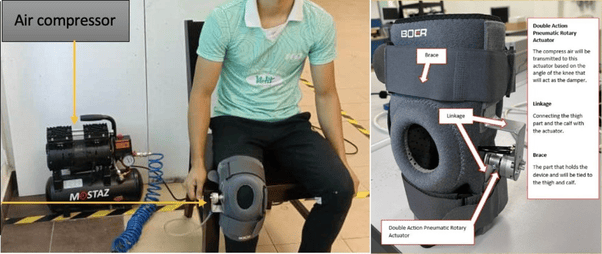As people age, conditions such as cataracts, back pain, hearing loss, and osteoarthritis (OA) often develop. OA is a degenerative joint condition where the cartilage cushioning the joints wears down over time. The result: pain, stiffness, and reduced mobility—especially in the knees. Many turn to knee braces or orthoses for support. However, there’s growing concern that most available braces don’t provide sufficient stiffness or effectively prevent knee buckling during walking.

The proposed pneumatic knee orthosis was tested using a knee rig. Significant increases in knee stiffness and falling time were recorded with pressurised air.
To address this, Professor Dr. Toong Hai Sam and Lim Kim Yew from the Faculty of Business and Communications (FBC) at INTI International University, in collaboration with other researchers, have developed a novel mechatronic knee orthosis powered by pneumatic technology.
Their research began with a survey of individuals aged 40 to 60. The findings were clear: 80% of respondents expressed a need for better knee support, underlining the demand for improved orthoses.
The team’s proposed solution is a pneumatic knee brace with adjustable stiffness. Pneumatic systems use compressed air or gas to create movement. In this design, a pneumatic rotary actuator is a key component.
According to Professor Toong and Lim, the actuator “functions as a controlled damper during the stance phase, providing additional stiffness to the knee, and is freed during the swing phase to avoid disrupting the leg’s natural movement.” The device stiffens when the foot is on the ground and releases when the leg swings forward.
Tests using a knee test rig showed significant improvement. The device increased knee stiffness and delayed falling time compared to standard braces—clear indicators of better support and fall prevention.
Looking ahead, the team plans to refine the control system and algorithm to better match walking phases. This will help simulate natural, human-like knee movement.
A device like this won’t cure osteoarthritis, but it offers something just as important—stability, movement, and the confidence to stay active. For many, that makes all the difference

Professor Dr. Toong Hai Sam and Lim Kim Yew from the Faculty of Business and Communications (FBC) noted that OA-related knee pain is degenerative, and no therapies can alter its progression. This often discourages walking and contributes to reduced physical activity and sedentary behaviour.